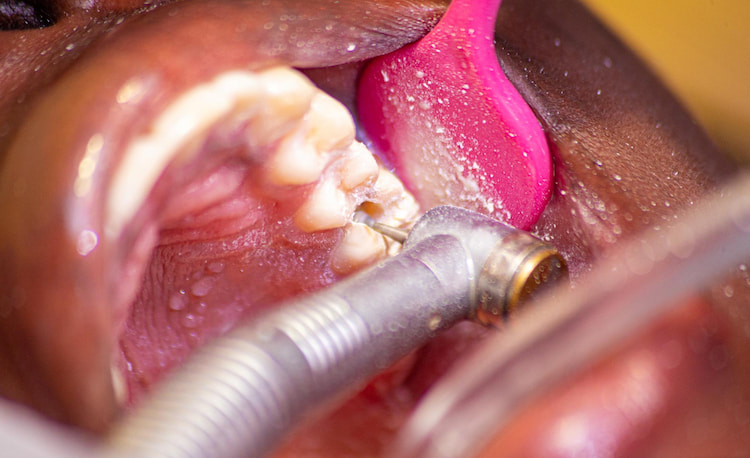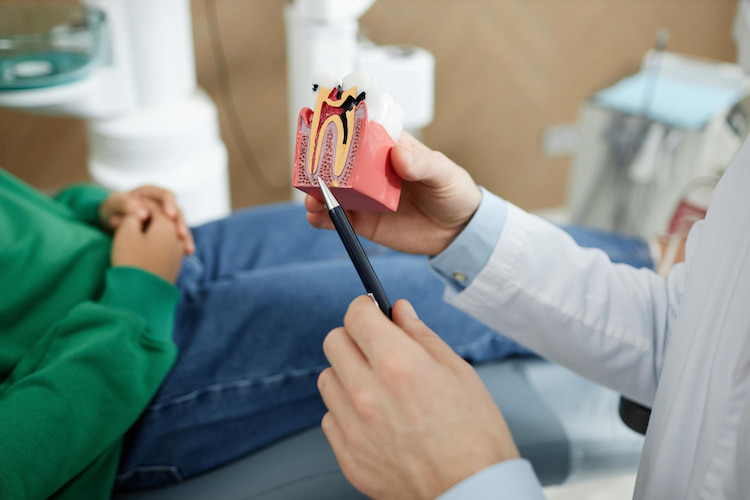Root canal treatment in Scarborough is a straightforward way to save a tooth that has been damaged or infected, typically concluding in one or two visits. Each visit lasts approximately one to one and a half hours. The process starts with a quick exam and ends with sealing the tooth to prevent future problems.
This treatment, rooted in endodontics, is all about keeping your natural tooth intact and your smile pain-free. Let’s dive into you’ll experience during root canal treatment in Scarborough.
Signs You May Need a Root Canal

When a tooth starts acting up, it might be hinting at the need for a root canal treatment. You’ll likely notice a sharp, nagging pain when you bite down on something, like a piece of toast or a crunchy apple, and that pain sticks around longer than it should. Sensitivity to hot or cold can also be a red flag; think of wincing when you sip hot tea or bite into ice cream, with the discomfort lingering for minutes.
Swollen gums near the tooth are another clue, sometimes paired with a small pimple-like bump that might leak pus if an infection’s taken hold. You might even see the tooth turning darker than its neighbours, a sign that the pulp inside is damaged.
Other hints include a loose tooth or a persistent bad taste in your mouth, like something’s just not right. In endodontics, the dental field that tackles these issues, catching these signs early can make the treatment smoother and prevent bigger headaches, like abscesses or tooth loss.
Read more: What Does an Endodontist Do to Treat Tooth Infections?
Step-by-Step Procedure of Root Canal Treatment in Scarborough
Root canal treatment might sound intimidating, but it’s a well-oiled process designed to save your tooth and get you back to normal. It’s the heart of endodontics, focusing on clearing out the infected pulp and sealing things up, typically in one or two visits, depending on the tooth’s complexity. Here’s how it goes down, step by step, so you know exactly what’s coming.
1. Diagnosis
Diagnosing the need for a root canal treatment starts with a relaxed chat about what’s been bothering you; maybe it’s pain when you chew or sensitivity that’s driving you nuts. The dentist will gently examine your mouth, tapping on the tooth to check for extra sensitivity or using hot and cold tests to see how the nerve reacts.
They’ll also take X-rays to get a clear picture of what’s happening inside, like whether an infection has spread to the bone or if the tooth’s canals look unusual. For more complicated cases, they might refer you to an endodontist in Scarborough, who’s got specialized tools, like high-powered microscopes, to dig deeper.
This step in endodontics is all about getting the full story on your tooth’s health, so the treatment plan is spot-on and you’re not left guessing about what’s wrong.
2. Consultation & Treatment Planning
After checking the exams and X-rays, the dentist will explain what’s going on, maybe that decay has reached the nerve or an infection has settled in the pulp. They’ll lay out a clear plan: how many visits you’ll need, what tools they’ll use, and whether a crown from a dental lab will be necessary to protect the tooth later.
For simple cases, they might dive in right away, but trickier ones get scheduled for a follow-up. They’ll also cover pain management, like prescribing antibiotics if there’s an infection or analgesics for any discomfort. This is your chance to ask about costs, especially if you’re using dental insurance, and how the process fits into Scarborough’s endodontic care scene.
3. Local Anesthetic
The first step is numbing the area with a local anesthetic, making sure you’re comfortable and don’t feel pain during the root canal treatment. It’s similar to getting a filling, but targeted right around the problem tooth. If you’re feeling anxious, they might offer mild sedation to help you relax, especially if you’re at a Scarborough clinic known for patient comfort.
4. Access
Once you’re numb, the dentist or endodontist drills a small opening in the top of the tooth to reach the pulp chamber. This access point is carefully made to get to the canals without harming the rest of the tooth, setting the stage for the next steps.

5. Cleaning & Shaping of Canals
Next, they use tiny, specialized files to remove the infected pulp and clean out the canals thoroughly. They shape the canals to be smooth and even, ensuring no bacteria are left behind and prepping them for a proper filling. This part is meticulous but crucial for a successful outcome.
6. Disinfection
After cleaning, they flush the canals with disinfectants to wipe out any lingering germs. This step in endodontics is like giving the tooth a deep clean to prevent future infections, ensuring the treatment lasts.
7. Temporary or Permanent Filling
Then, they fill the canals with a rubbery material called gutta-percha and seal it up tight. If it’s a one-visit procedure, the seal might be permanent; otherwise, a temporary filling keeps things secure until your next appointment.
8. Post-op Restoration (Crown)
Once the root canal treatment is complete, you’ll likely need a dental crown from a dental lab to protect the tooth. This restores its strength and makes it look natural, typically placed a week or two later by your general dentist to finish the job.
Watch this video and get more details about what happens during the treatment.
Pain Control & Medications
During the root canal treatment, the local anesthetic keeps things pain-free, so you’ll likely only feel some pressure, not sharp pain. Afterward, any soreness is usually mild, like a slight ache when you chew, and can be managed with over-the-counter analgesics like ibuprofen or acetaminophen. If there’s swelling or signs of infection, your dentist might prescribe antibiotics to knock it out quickly.
Endodontists often suggest using an ice pack for the first few hours to reduce any puffiness and recommend avoiding crunchy foods like nuts or chips. The goal in endodontics is to make the whole experience as comfortable as possible, so you’re back to your routine fast.
Read more: Tooth Sensitivity After a Root Canal Therapy
Aftercare & Recovery Timeline
After your root canal treatment, take it easy on the tooth and follow the tips below:
- Stick to soft foods like yogurt, scrambled eggs, or soup for the first day or two.
- Keep up with brushing and flossing, but go gently around the treated area to avoid irritation.
- Rinse with warm salt water to help if there’s minor swelling.
- Sleep with an extra pillow to keep your head elevated.
Most people feel back to normal within a few days, with any tenderness fading quickly, though the tooth’s inner healing takes a bit longer. If you’re prescribed antibiotics or analgesics, follow the instructions. Follow-up visits in endodontics are quick check-ins to ensure everything’s healing properly, so you can chew and smile without worry.
Have Questions or Need Advice?
Fill out the form below and we’ll contact you for a quick consultation.
Risks & Complications of Root Canal Therapy
Root canal treatment is generally smooth, but there are a few risks to keep in mind. If some bacteria get left behind, an infection could linger, or the tooth might crack if it doesn’t get a crown soon. In rare cases, a tiny tool might break inside the canal, but endodontic experts are trained to handle that. Swelling or a reaction to medications can happen, too.
If you notice:
- Pain is getting worse after a couple of days,
- swelling is spreading to your face,
- Or a fever is creeping in,
…call your dentist or endodontist right away; these could signal a problem needing quick attention. Emergency dental care in Scarborough is available for urgent situations like these.
Cost, Insurance & Public Programs in Scarborough
A root canal treatment in Scarborough typically costs between $800 and $2,100, plus the cost of a filling, depending on the tooth’s location and whether it’s handled by a general dentist or an endodontist. Adding a crown from a dental lab can increase the total cost by $1500 or more.
Dental insurance often covers 50-80% of endodontic procedures, but you’ll want to check your plan’s details to avoid surprises. For those without insurance, programs like Healthy Smiles Ontario can cover kids from low-income families, while seniors might qualify for the Ontario Seniors Dental Care Program, offering free or low-cost care. Scarborough’s Toronto Public Health clinics also provide affordable options for folks who need dental help but are short on funds.
Book Your Root Canal in Scarborough Today
Don’t wait until the pain gets worse; our experienced dentists in Scarborough are here to make your root canal treatment smooth and stress-free. Book your appointment now and take the first step toward a healthier smile.
Choosing The Right Scarborough Provider
Finding the right place for your root canal treatment can make all the difference in how smooth things go. Look for a clinic with great reviews, flexible hours that fit your schedule, and a reputation for handling emergencies if you need quick relief.
Endodontist vs. General Dentist
An endodontist in Scarborough specializes in endodontics, doing root canals day in and day out with advanced tools like microscopes, making them ideal for complex cases like molars with tricky canals. A general dentist can handle simpler root canals and might be more budget-friendly, but they’ll refer you to a specialist if the case gets too complicated.
Emergency Options
If tooth pain hits out of the blue, Scarborough’s emergency dental clinics, like those in Cedarbrae or near Parkway Mall, can offer same-day root canal treatments to get you out of pain fast. These spots are lifesavers when you can’t wait for a regular appointment.
What to Ask at Booking
When you book your appointment, ask why the root canal treatment is needed, how long the process will take, and what they’ll do to keep you comfortable. Make sure to clarify costs, whether they accept your dental insurance, and what aftercare involves. Asking about their experience with endodontics can also give you peace of mind that you’re in good hands.

Root Canal Treatment in Scarborough Here; Take Action Now!
Root canal treatment is a reliable way to save a hurting tooth in Scarborough, stopping pain and keeping bigger dental problems at bay. By understanding the signs, steps, and aftercare involved in endodontics, you can walk into the dentist’s office feeling prepared and walk out with a healthier smile.
If you’re dealing with tooth pain or just want to learn more about your options, contact us at Lawrence Dental Centre. Our friendly team offers everything from consultations to emergency root canal treatments, making sure you’re taken care of with expertise and a welcoming vibe.
FAQ
How long does a root canal take?
A root canal usually takes about 60 to 90 minutes per visit, though some teeth, like molars with multiple canals, might need two sessions. Front teeth are often quicker due to simpler canal structures.
Do they use anesthesia for a root canal, and does it hurt?
Yes, local anesthesia numbs the area completely, so you won’t feel pain during the root canal treatment, just some pressure. Post-treatment soreness is mild and easily managed with over-the-counter meds like ibuprofen.
How much will a root canal cost in Scarborough, and does insurance cover it?
In Scarborough, a root canal costs $800 to $2100, depending on the tooth and whether it’s done by a general dentist or endodontist. Dental insurance typically covers 50-80%, but you should confirm with your provider.
Have you ever had a root canal treatment? Share your experience or any questions you may have in the comments below; we’d love to hear from you!
Have Questions or Need Advice?
Fill out the form below and we’ll contact you for a quick consultation.

